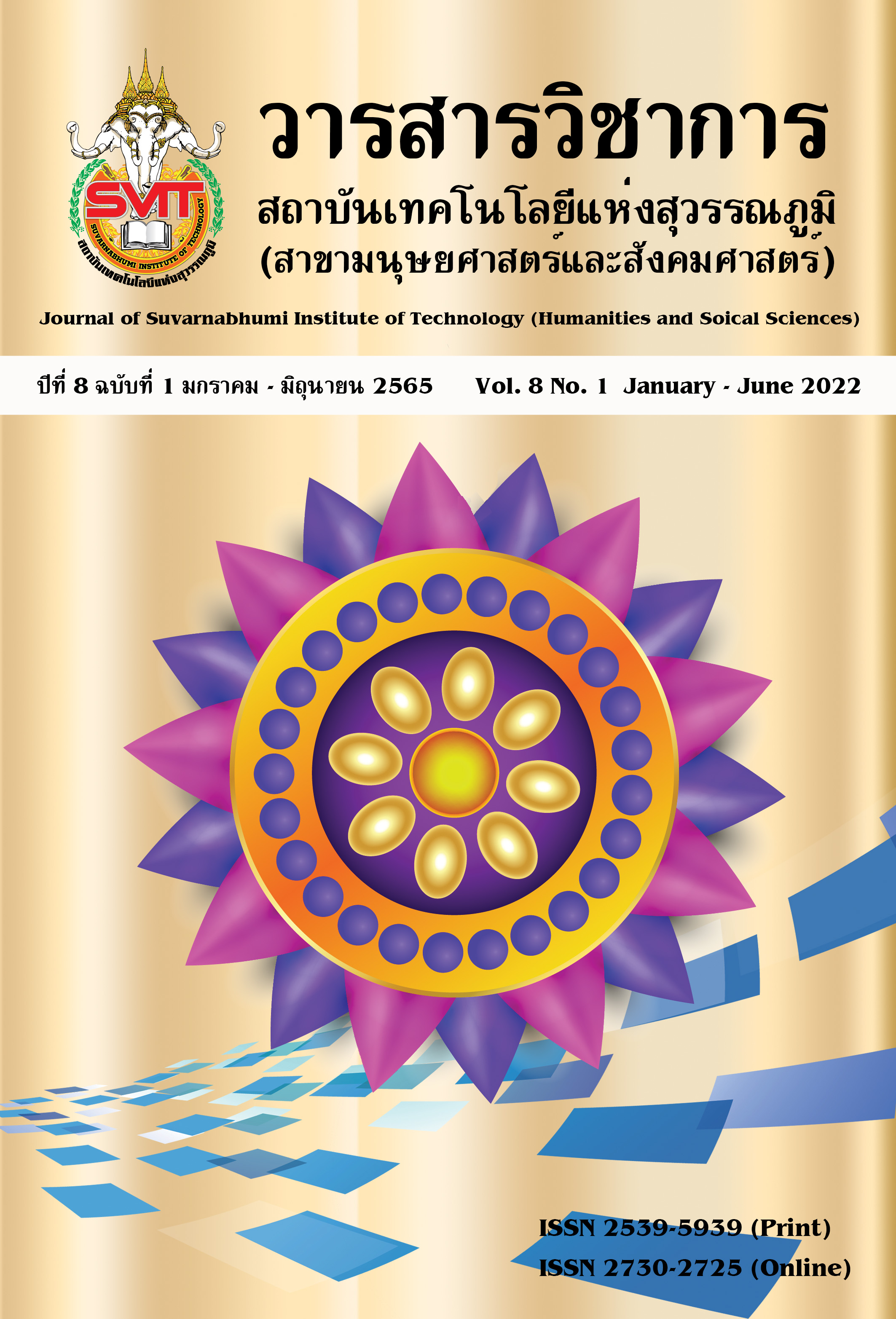STRUCTURAL INFLUENCE OF COMPETENCY, WORKING ENVIRONMENT AND EMPLOYEE SATISFACTION AFFECTING THE EMPLOYEE LOYALTY OF THE MACHINERY MANUFACTURING INDUSTRY IN RAYONG PROVINCE
Keywords:
Competency, Work Environment, Employee Satisfaction, Employee LoyaltyAbstract
The objectives of this research is to 1) study the level of the competency, working environment, employee satisfaction and employee loyalty, 2) study the influence of employee satisfaction as the mediator between the competency and the employee loyalty, and 3) study the influence of employee satisfaction as the mediator between the working environment and employee loyalty in the machinery manufacturing industry, Rayong Province. The samples used in the research were 175 employees in the machinery manufacturing industry in Rayong Province. The research tool was a questionnaire. The statistics used in research consist of frequency, percentage, mean and standard deviation values. The structural equation model (SEM) was analyzed by using Smart PLS 3.0 program.
As results, it was found that (1) employees of the machinery manufacturing industry in Rayong Province have an overall level of competency, working environment, employee satisfaction and employee loyalty at a high level with the mean values of 3.94, 3.85, 3.85 and 3.82, respectively, and the standard deviations of 0.570, 0.650, 0.664 and 0.812, respectively, (2) the employee satisfaction is the mediator connecting the competency to the employee loyalty with the lower bound coefficient of 0.570 and the upper bound of 0.907, and (3) the employee satisfaction is also the mediator connecting the work environment to the employee loyalty with the lower bound coefficient of 0.582 and the upper bound of 0.912. The results shown that the competency results in the employee satisfaction, and the working environment affects the employee satisfaction. The employee satisfaction is the most important factor affecting employee loyalty, significantly.
References
ธนวัฒน์ มั่นเหมือนป้อม. (2559). วัฒนธรรมองค์การและความพึงพอใจในการทำงานที่พยากรณ์ความจงรักภักดีของพนักงานในโรงงานอุตสาหกรรมอาหาร (วิทยานิพนธ์ปริญญามหาบัณฑิต). กรุงเทพฯ:มหาวิทยาลัยเทคโนโลยีพระจอมเกล้าพระนครเหนือ.
บริษัท ดานิลี่ จำกัด. (2563). ข้อมูลจำนวนพนักงานบริษัท. ระยอง: ฝ่ายบุคคล.
ไพรัช ศิลาศรี. (2559). ความสัมพันธ์ระหว่างความพึงพอใจในการทำงานกับความจงรักภักดีและความ ผูกพัน ต่อองค์การของพนักงานบริษัทนากาชิมา รับเบอร์ (ประเทศไทย) จำกัด (วิทยานิพนธ์ปริญญามหาบัณฑิต). พระนครศรีอยุธยา: มหาวิทยาลัยราชภัฏพระนครศรีอยุธยา.
สถาบันเหล็กและเหล็กกล้าแห่งประเทศไทย. (2563). สืบค้น 1 พฤศจิกายน 2563, จาก https://miu.isit.or. th/box/Download/322/Machinery%20Outlook_Q4,%202020.pdf
ศตวรรษ กล่ำดิษฐ์. (2560). สมรรถนะที่ส่งผลต่อการปฏิบัติงานของพนักงานฝ่ายผลิต ในอุตสาหกรรมการผลิตสายไฟฟ้า กรณีศึกษาบริษัท สายไฟฟ้าไทย-ยาซากิ จำกัด (การค้นคว้าอิสระปริญญามหาบัณฑิต). กรุงเทพฯ: มหาวิทยาลัยเทคโนโลยีราชมงคลกรุงเทพ.
ศิวพร โปรยานนท์ (2554). พฤติกรรมของผู้นำและสภาพแวดล้อมการทำงานที่ส่งผลต่อความสร้างสรรค์ในงานของบุคลากร กรณีศึกษาองค์การธุรกิจไทยที่มีนวัตกรรมยอดเยี่ยม (วิทยานิพนธ์ปริญญามหาบัณฑิต).กรุงเทพฯ: สถาบันบัณฑิตพัฒนบริหารศาสตร์.
ศุภลักษณ์ พรมศร. (2558). ความสัมพันธ์ระหว่างสภาพแวดล้อมในการทำงาน การรับรู้รูปแบบภาวะผู้นำของพนักงานความผูกพันในงานกับความพึงพอใจในงาน (วิทยานิพนธ์ปริญญามหาบัณฑิต). กรุงเทพฯ: มหาวิทยาลัยธรรมศาสตร์.
อลิษา กำแพงเงิน, ธัญนันท์ บุญอยู่, และสมใจ บุญทานนท์. (2562). ตัวแบบความสัมพันธ์โครงสร้างเชิงสาเหตุของสภาพแวดล้อมขององค์การและคุณภาพชีวิตในงานที่มีผลต่อการรับรู้ความสุขในการทำงานของพนักงานธนาคารกสิกรไทย จำกัด (มหาชน). วารสารปัญญาภิวัฒน์, 11(3), 124-137.
Benitez, J., Henseler, J., Castillo, A., & Schuberth, F. (2020). How to perform and report an impactful analysis using partial least squares. Guidelines for confirmatory and explanatory IS research. Information & Management, 57(2), 1–16.
Chetna, P., & Rajni, K. (2012). Impact of job satisfaction and organizational commitment on employee loyalty. International Journal of Social Science & Interdisciplinary Research, 1(8), 26-41.
SHI, H. (2014). The Relationship between job satisfaction and employee loyalty in the manufacturing industry of China. Universiti Teknologi Malaysia
Nikolajevaite, M. (2016). Relationship Between Employees’ Competencies and Job Satisfaction: British and Lithuanian Employees. Psychology Research, 6(11), 684-692.
Hair, J. F., Howard, M. C., & Nitzl, C. (2020). Assessing measurement model quality in PLS-SEM using confirmatory composite analysis. Journal of Business Research, 109, 101–110.
Karamanis, K., Arnis, N., & Pappa, P. (2019). Impact of working environment on job satisfaction: Evidence from Greek Public Sector. Theoretical and Empirical Researches in Urban Management, 14(3), 5-21.
Likert, R. A. (1932). A technique for the measurement of attitudes. Archives of Psychology, 140(22), 5-55.
Nyoman, W. (2018). Organization culture competency compensation job satisfaction and lecturer loyalty. Journal of Business on Hospitality and Tourism, 4(1), 1-19.
Cheptoo, R. (2020). The Role of Competency in Curbing Youth Unemployment: Competencybased Curriculum Approach. International Journal of Education, 8(4), 33-37.
Yuliyant, I. (2020). The Effect of Career Development and Work Environment on Employee Loyalty with Work Satisfaction as Intervening Variables. The International Journal of Social Sciences World, 2(2), 20-31.
Downloads
Published
Issue
Section
License
Copyright (c) 2022 Suvarnabhumi Institute of Technology

This work is licensed under a Creative Commons Attribution-NonCommercial-NoDerivatives 4.0 International License.
บทความที่ได้รับการตีพิมพ์เป็นลิขสิทธิ์ของวารสารวิชาการ สถาบันเทคโนโลยีแห่งสุวรรณภูมิ
ข้อความที่ปรากฏในบทความแต่ละเรื่องในวารสารวิชาการเล่มนี้เป็นความคิดเห็นส่วนตัวของผู้เขียนแต่ละท่านไม่เกี่ยวข้องกับสถาบันเทคโนโลยีแห่งสุวรรณภูมิ และคณาจารย์ท่านอื่นๆในสถาบันฯ แต่อย่างใด ความรับผิดชอบองค์ประกอบทั้งหมดของบทความแต่ละเรื่องเป็นของผู้เขียนแต่ละท่าน หากมีความผิดพลาดใดๆ ผู้เขียนแต่ละท่านจะรับผิดชอบบทความของตนเองแต่ผู้เดียว





